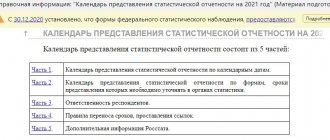Regulatory framework for primary documents
To reflect any business transaction in accounting, it is necessary to have a correctly executed primary document, as stated in paragraph 1 of Art. 9 of the Law “On Accounting” dated December 6, 2011 No. 402-FZ. Next we read in paragraph 4 of Art. 9 of this law, that the forms of primary documents must be developed and approved by the organization. Thus, the use of unified forms of primary documents is optional, with the exception of certain cases. The only obligatory condition is the presence of certain details in the document. On the other hand, there is no ban on the use of unified forms of documents, so the head of the organization must independently determine which forms of primary documents should be used:
- unified forms;
- independently developed forms with mandatory details;
- a combination of the first two options.
The decision made must be fixed in the accounting policy and the forms of primary documents used by the organization must be attached to it.
Rules for drawing up primary documents
Let us next consider the primary documents on wages that must be used when accounting for settlements with employees. The article will provide unified forms. They can be processed in accordance with the needs of the enterprise’s accounting department, leaving in any case the mandatory details listed in clause 2 of Art. 9 of Law 402-FZ:
- Title of the document;
- date of document preparation;
- name of the economic entity that compiled the document;
- content of the fact of economic activity;
- the value of the natural or monetary measurement of the fact of economic activity, indicating the units of measurement;
- the name of the position of the person who performed the transaction and is responsible for its execution.
Primary documents on wages can be drawn up both on paper and in electronic form. In the second case, they must be signed with an electronic digital signature.
Types of statements for calculation and payment of salaries
Each enterprise or individual entrepreneur can independently choose a document that will become the main one in the matter of monetary relations with the employee. To give an employee money, you first need to make an accrual on paper. Some employers prefer to prepare a separate statement for each employee in order to maintain trade secrets about the monetary remuneration of each employee. This is necessary to avoid disagreements within the team.
This is also important to know:
How to calculate maternity benefits yourself
But preparing an individual wage statement is labor-intensive and costly, because in order to report to the inspection authorities, each document must be attached to the report not in electronic form, but in paper form. Just imagine how much money you will have to spend just to pay salaries for each employee. It is also worth taking into account vacation pay, advances and sick leave.
To give an employee money, you first need to make an accrual on paper.
Therefore, general wage statements were adopted. The only difference is in the form the company uses:
- Payroll sheet for all employees.
- Statement for issuing wages for all employees.
- A unified form where payments are made and money is issued at the same time.
Which form to choose is up to you.
Time sheet and calculation of wages
The employee is paid based on the amount of time he works.
To record it, use form No. T-12 “Working time sheet and calculation of wages” or form No. T-13 “Working time sheet”. The T-12 form contains data on actually worked and unworked time based on sick leave, certificates, applications, orders.
The title page indicates the name of the organization, the date of preparation and document number, the reporting period and codes for indicating worked and unworked time in the accounting table.
Section 1 “Working Time Accounting” consists of 17 columns and is intended to reflect information about attendance and absence from work for one calendar month. Filled in for each employee: his/her full name, personnel number, then on the dates of the month in columns 4 and 6 in the top line a code indicating attendance at work or the reason for absence is indicated, in the bottom line - the number of hours worked that day, overtime hours are marked with a fraction. Columns 5 and 7 are intended to reflect the sum of days of visits and hours actually worked for each half-month. In the columns of the missing numbers of the month, put the sign “X”.
According to the rules, you can fill in the cells for all days of the month, and only for days other than a regular working day (vacation, sick leave), leaving the cells of a regular working day empty.
Section 2 “Payment payments to personnel” consists of two pages. The third page of the timesheet is intended to reflect each type of payment for the month for each employee.
The fourth page of the report card summarizes information about attendance at work for the organization as a whole for each day of the month. Download an example of filling out the T-12 form.
Form T-13 represents only the title page and section 1 for recording working hours of Form T-12. Then it is assumed that the accountant keeps records of salaries in other registers.
Payroll
The following block of primary documents for payroll accounting:
- payroll statement (form T-49);
- pay slip (form T-51);
- payroll (form T-53).
IMPORTANT! It is necessary to reflect the amounts of accrued wages only in unified forms.
As the names indicate, form T-49 is a combination of forms T-51 and T-53, so the accountant draws up either one payroll sheet, or a payroll sheet and a payroll sheet.
The payroll sheet is used to calculate and pay wages in cash from the company's cash desk. It contains the number and date of compilation, signatures of the manager and chief accountant, the total amount of payment to all employees, as well as the start and end dates for the payment of wages from the cash register - this period is equal to five working days.
The statement contains information about the personnel number, position, tariff rate and hours worked for each employee. The accountant enters into it all accrued amounts for all types of payments, as well as all deductions for the period for which funds are paid to the employee. This can be either an advance, or wages, or vacation pay, and so on.
At the end of the statement, information about the amount paid and deposited (if any), the signature of the responsible person and the number of the cash receipt order for which the payment was made are entered.
The far right column is filled in by employees of the organization, where they sign to confirm receipt of funds from the cash register. Amounts not received within five days are deposited.
Sample payslip.
Salary slip: sample filling
The title page of the payroll slip contains the following details:
- name and OKPO code of the company;
- debit account;
- validity period of the document;
- the total amount intended for payment under this statement;
- signatures of the head of the enterprise and the chief accountant with the date of signature;
- name of the document, its number and date;
- duration of the billing period.
The salary slip (a sample of which we are considering) can be drawn up on several pages, and their total number must be indicated in the corresponding line. These pages, which follow the title page, contain a table that shows:
- serial number of the record;
- employee’s personnel number and full name;
- amount, and in the next column the employee puts a mark on receipt (his personal signature) or, if the money was not received, the cashier puts down “deposited”.
The “Note” column usually indicates the number of the identification document that is presented by the recipient of the money. This is practiced if there is a very large staff and the cashier does not know everyone by sight.
At the very bottom of the document, the cashier indicates how much money was paid and how much was deposited. The signature of the person responsible for issuing money (usually the cashier) is affixed, and the number and date of the cash receipt order are affixed. The accountant who checked the statement handed over by the cashier along with the cash reports puts his signature and indicates the date of the check.
Payroll and payslip
If employees receive wages on bank cards, then only a payslip is drawn up in form T-51.
What other documents are needed in this case, we will consider below. If an accountant calculates wages in a different register, you can only prepare a payroll.
The pay slip in Form T-51 reflects only calculations for each employee. Here you will find an example of filling.
At the beginning of the payroll, you must indicate the date of receipt of funds at the cash desk for issuance to employees and the end date of issuance.
The payroll in form T-53 reflects the amount of payments to each employee, their receipt of receipt of the specified amount, and also at the end of the statement - the total paid and deposited amount, as well as the number of the cash order for payment of wages, sample at the link.
If an accountant uses a statement in the T-53 form in his work, he needs to draw up a register of issued statements in the T-53a form, where the serial number of the payroll and the amount paid on it are entered. The register is compiled for one calendar year. Here is an example of filling out the form.
Let's sum it up
To simplify the work of an enterprise or individual entrepreneur, special payroll forms were approved. For state enterprises - one form, for commercial organizations, individual entrepreneurs or legal entities - other types of forms.
What to choose as a basis, each employer decides for himself. The unified form T-49 for private owners, 0504401 for public sector employees, is popular. But such documents can be used if wages are paid in cash through the organization’s cash desk. If the employer switches to issuing money to employees via plastic cards, then there is no need to issue a unified form. Here you only need a payslip, which only the accountant signs. The employee's signature is not required anywhere.
If you issue salaries to employees on a bank card, then you do not need to fill out the T-49 statement.
Payrolls are very important in the work of an entrepreneur; their preparation must be taken seriously. If the enterprise has the concept of a trade secret, then it is more convenient to maintain individual statements for each employee.
Subscribe to the latest news
Personal accounts of employees
For each employee of the organization, the accountant must maintain a personal account in form T-54, which reflects the employee’s personal data: full name, tax identification number, SNILS, marital status.
It also contains data about work at a given enterprise: date of entry, transfers, dismissals, changes in wages, vacations, and so on. Every month, the accountant enters into the personal account data on the amount of time worked by the employee, the amounts accrued to him for all types of payments, all deductions from wages, and data on sick leave.
The last columns contain information about the final amount to be paid for each month, as well as about the debt to the employer or, conversely, to the employee.
Sample employee account.
How to fill it out correctly
The key rules for drawing up documents are enshrined in Resolution of the State Statistics Committee No. 1 of 2004. Let us determine the procedure for drawing up using form No. T-53 as an example.
We start filling out with the title page. First of all, we register the name of the organization, then enter the name of the structural unit. Now we indicate the payment deadline.
We indicate the amount due for issuance first in words and then in numbers. Then the title page is signed by the director and chief accountant of the company, indicating the full name. We indicate the date of signing.
This is important to know: Payment of scholarships under a student agreement with an employee
We write down the document number, the date of its formation (drawing up) and the billing period for which the information was reflected.
We proceed to filling out the tabular part of the form. Here we first indicate the record number in order, then enter the employee’s personnel number. Last name and initials, as well as the amount to be paid. The employee must sign for receipt nearby.
After filling out the table, the results are summed up. Certified by the signature of the cashier and the responsible accountant.
Payslips
The law obliges the employer to issue pay slips to employees along with their wages, which clearly indicate what the amount received by the employee consists of.
Salaries are received at least twice a month, however, it is more reasonable to issue a pay slip once, when paying wages for the month, and not when paying wages for the first half of the current month, since in the second case the calculation indicated in the slip may be incomplete and does not reliably reflect the origin of the amount paid. The payslip does not have a regulated form, so the organization must independently develop it, based, for example, on forms T-12 or T-51. Or create your own form entirely, which should be fixed in the accounting policy. The payslip must indicate all parts of the salary: salary, bonus, allowances, bonuses, sick leave payments, and so on. It is necessary to indicate all deductions: personal income tax, alimony, fines, etc. As a result, the amount to be paid should be obtained, which the employee receives in his hands along with the pay slip.
The payslip, upon agreement with the employee, can be issued both in paper form and electronically, by sending it to the employee’s email.
Frequency of filling
In most cases, employees are paid twice a month. Such conditions are specified in the Labor Code of the Russian Federation; for violating it, the company risks incurring administrative liability. Moreover, the first payment is considered an advance payment (usually a percentage of the salary), and the second payment is considered the main payment (the remaining part of the amount). Thus, a simple payslip will be issued for the advance (it indicates the amount that was paid in the first half of the month).
This is also important to know:
How and for how long sick leave is paid
Form T-51 serves to illustrate and document the main part of the payment of wages to employees of the institution.
The column “Retained and credited” in the tabular part of the document must also take into account the advance part - data from the first paper.
Salary project
At the moment, the most common way to receive wages is to transfer it to the employee’s bank card.
This can happen either individually or on an ongoing basis and for all employees at the same time. There are two options for receiving money on a card: transferring it to each employee separately or registering a salary project with a credit institution. To receive wages on a bank card, the employee must write a statement about this and attach to it the card details for transferring funds.
If the organization has entered into an agreement with a credit institution on a salary project, then the employee signs an application for the issuance of a card within the framework of this project or writes an application attaching the details of the card he already has.
If the employee does not want to receive wages on the card, he does not sign any statements and continues to receive money at the organization’s cash desk.
The method for employees to receive wages on a bank card or at the organization’s cash desk must be specified in the collective, labor agreement or in an additional agreement to it.
Other primary documents
In addition to the listed main primary documents, these include the following documents, which are compiled to reflect the facts of economic activity that are directly related to payroll calculation:
- an employment contract with an employee, where the system and amount of remuneration must be specified;
- orders for transfer to another position or salary changes;
- applications and orders for all types of vacations, since the time spent on vacation affects the calculation of wages;
- orders for payment of bonuses and bonuses;
- certificates of incapacity for work;
- applications and orders for business trips;
- applications and orders for hiring and dismissal, as well as for payment of various types of compensation upon dismissal;
- other documents directly related to the calculation or affecting the amount of wages of each employee of the organization.
***
An organization has the right to develop primary documents for payroll accounting independently or use standardized forms. They can be issued either in paper or electronic form, signed with an electronic signature. It is important to make payroll calculations accurate and as transparent as possible for the employee. For this purpose, detailed calculation forms are used, taking into account all the features of working conditions and pay slips issued to employees, which reflect all the steps of the calculation.
Source: legal and tax portal People's Adviser
Responsibility for violation of the procedure for maintaining and preserving frames of documents
In the absence of mandatory personnel documents approved by the organization, the inspecting labor inspector may bring the organization to administrative liability. Thus, in accordance with Article 5.27 of the Code of Administrative Offenses of the Russian Federation, violation of labor and labor protection legislation entails the imposition of an administrative fine:
- for officials - in the amount of 1,000 to 5,000 rubles,
- for legal entities - from 30,000 to 50,000 rubles. or suspension of activities for up to 90 days.
Violation of labor and labor protection legislation by an official who has previously been subjected to administrative punishment for a similar administrative offense entails disqualification for a period of one to three years.
In accordance with Article 13.20 of the Code of Administrative Offenses of the Russian Federation, for violation of the rules of storage, acquisition, accounting or use of archival documents (such documents include: work books, personal cards of employees, orders for personnel, etc.) entails:
- warning or imposition of an administrative fine on citizens in the amount of 100 to 300 rubles,
- for officials - from 300 to 500 rubles.
In accordance with Article 90 of the Labor Code of the Russian Federation, persons guilty of violating the rules governing the receipt, processing and protection of employee personal data are subject to disciplinary and financial liability in the manner established by the Labor Code and other federal laws, and are also subject to civil penalties , administrative and criminal liability in the manner established by federal laws.
The same provision applies to employees responsible for maintaining, storing, recording and issuing work books.
In accordance with Article 137 of the Criminal Code of the Russian Federation, illegal collection or dissemination of information about the private life of a person, constituting his personal or family secret, without his consent, or dissemination of this information:
- in public speaking
- publicly displayed work,
- in mass media,
are punished:
- a fine of up to 200,000 rubles,
- or in the amount of wages or other income of the convicted person for a period of up to 18 months,
- or compulsory work for up to 360 hours,
- or correctional labor for up to 1 year,
- or forced labor for a period of up to 2 years with or without deprivation of the right to hold certain positions or engage in certain activities for a period of up to 3 years,
- or arrest for up to 4 months,
- or imprisonment for up to 2 years with deprivation of the right to hold certain positions or engage in certain activities for up to 3 years.
This is also important to know:
Gray salary: judicial practice, is there any point in suing, employer’s responsibility
In this case, the same acts committed by a person using his official position are punishable:
- a fine in the amount of 100,000 to 300,000 rubles,
- or in the amount of wages or other income of the convicted person for a period of 1 to 2 years,
- or deprivation of the right to hold certain positions or engage in certain activities for a period of 2 to 5 years,
- or forced labor for a period of up to 4 years with or without deprivation of the right to hold certain positions or engage in certain activities for a period of up to 5 years,
- or arrest for up to 6 months,
- or imprisonment for a term of up to 4 years with deprivation of the right to hold certain positions or engage in certain activities for a term of up to 5 years.
The timeliness, completeness and correctness of maintaining personnel documentation, as well as compliance with labor legislation and other regulatory legal acts containing labor law norms, are controlled by the State Archive and the Labor Inspectorate, which conduct periodic scheduled and unscheduled inspections.
Complaints from employees can be considered by the Prosecutor's Office together with the Labor Inspectorate.
Actions in case of loss
According to the Letter of the Ministry of Labor dated November 27, 2001 No. 8389-YuL, responsibility for storing the salary slip rests with the employer.
If lost, it is necessary to issue an order to create a commission to investigate the incident. It includes employees of the accounting department, personnel department, etc. The Commission must request explanatory notes from all parties who were responsible for storage. After conducting an investigation, a report is drawn up. It indicates the reasons that led to the loss of the statement and recommendations for measures to restore it.
The best option to solve the problem is to restore the document. To do this, the payslip is reprinted. All signatures are affixed, including employees.
If it is impossible to fill in the lines due to the dismissal of some employees, you should leave them blank or indicate “could not be restored.”
Free legal consultation
We will answer your question in 5 minutes!
Free legal consultation We will answer your question in 5 minutes!
Call: 8 800 511-39-66
Ask a Question
The duplicate statement must be marked “Duplicate”.
Thus, the salary slip is an integral document when calculating wages to employees. Depending on the method of issuing money, the document is divided into forms No. T-51, No. T-53, No. T49.
The accountant fills out the document. The chief accountant and the head of the enterprise signs and is responsible for incomplete payment of wages to employees or payment in excess of what is necessary.
This is also important to know:
Accident at work: what is it, types of payments, actions of the employee and employer
If mistakes are made, corrections are allowed. The statement is kept in the accounting department for 5 years.




